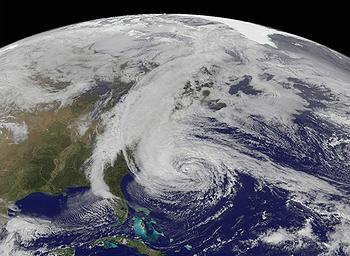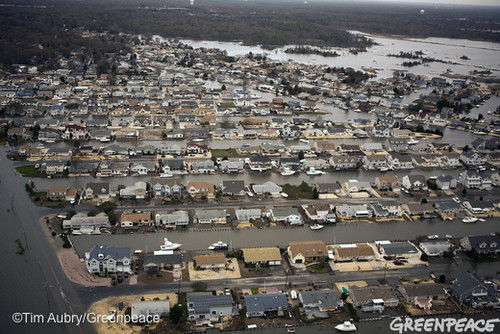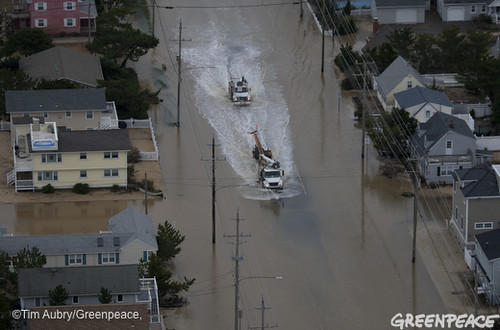許多環保人士指稱,嚴重摧毀紐約、紐澤西及其他大西洋沿岸至新英格蘭地區15個州的超級颶風珊蒂,乃是氣候變遷的產物。而某些氣象學家卻不這麼想,他們認為即使沒有氣候暖化,珊蒂這般的颶風一樣會出現。
曼哈頓非營利組織「美國環境防護基金會」(Environmental Defense Fund)執行長Fred Krupp表示,「珊蒂不只是一個氣象災害,更是氣候災難。」Krupp表示,「人類活動造成的全球暖化導致海平面升高、大西洋水溫上升以及大氣中濕度增加,這三項因素使颶風夾帶了毀滅性的力量。」
據美聯社統計,珊蒂造成之死亡人數已上升至50人,且死亡人數在搜索和救援人員完成他們嚴峻的任務前,仍可能繼續增加。
颶風於10月29日晚間從大西洋城(Atlantic City)附近登陸後,西至密西根州等17個州共有超過820萬戶家庭停電。 有近200萬停電戶位於紐約市,愛迪生聯合電力公司(Con Edison)關閉了曼哈頓市中心高樓與下城負責供暖的電力和蒸汽。 由於淹水和停電,有4座位於紐約及紐澤西的核電廠受到影響,其中三座電廠已經關閉,一座處於戒備狀態。
愛迪生聯合電力公司,表示紐約市及其鄰近地區的電力,可能需要一個星期才能恢復。
紐約證券交易所(New York Stock Exchange, NYSE)連續關閉兩日後,已逐步恢復正常,於31日恢復交易,紐約市長彭博(Michael Bloomberg)到場敲響開市鐘。
環保人士指稱,這一切的結果都是因為燃燒化石燃料,使上兆噸二氧化碳等溫室氣體進入地球大氣層,進而造成氣候變化所導致的。
健康氣候倡導團體350.org負責人Bill McKibben表示,「化石燃料工業造成了氣候的危機,導致更多如颶風珊蒂這樣的極端天氣事件。我們呼籲大型石油商停止花費數百萬元來影響選舉,而應該捐助救災。他們應該援助氣候變遷帶來的傷害,而非選擇掩蔽事實。」
McKibben 表示,「颶風珊蒂的出現是溫度上升一定程度後的結果。曾預測這種超級颶風產生的科學家們再次發出嚴厲的警告:如果依照目前的情況,我們的孩子將生活在一個過熱的地球,溫度將比現在更高四到五度。而我們不能讓這種情況發生,因此,讓我們做些改變吧。」
但氣象軟體AccuWeather的高級氣象學家Dan Kottlowski卻表示,他不認為如此具破壞力的風暴是氣候暖化的結果。他認為,該風暴造成如此的嚴重破壞,不是因為其強度,而是行進路線。
Kottlowski 表示,珊蒂的行進路線在10月發生的風暴中,是相當普遍的。但多數情況下,它都會轉向東方前進。我們從來沒有見過它轉向西北前進,這就是為什麼它會襲擊紐澤西州與紐約港。氣候變遷無法解釋這現象。 他接著說,「我不認為一個風暴可以說是氣候變遷所導致的結果。如果你問,若氣候沒有變暖,這事會不會發生?我的回答是肯定的,它仍然會發生。」
 Kottlowski解釋道,颶風在溫暖海域更容易形成,而大西洋每40年有一個升溫的周期變化。我們現在就處在這個週期的中段。大多數氣候學家認為,未來15年中,我們將處於較暖和的階段。同樣的情況亦發生在1950年代與1930年代。這與氣候變遷沒有關係。
Kottlowski解釋道,颶風在溫暖海域更容易形成,而大西洋每40年有一個升溫的周期變化。我們現在就處在這個週期的中段。大多數氣候學家認為,未來15年中,我們將處於較暖和的階段。同樣的情況亦發生在1950年代與1930年代。這與氣候變遷沒有關係。
科羅拉多州立大學大氣科學系博士William Gray認為,二氧化碳的增加與大西洋表層海水溫度(sea surface temperature, SST)及颶風活動的增加沒有關係。
在Gray博士預測2012年下半年大西洋颶風活動的研究中指出,基於物理條件下,我們沒有理由相信,全球或大西洋海水溫度上升1-2°C,會對大西洋颶風的頻率和強度造成顯著地影響。
如果其他許多基本條件沒有相應的變化,如:垂直風切(vertical wind shear)或中等濕度(mid-level moisture)等,熱帶氣旋(tropical cyclone, TC)活動極少或根本不會隨表層海水溫度而增加。 Gray強調,大西洋表層海水溫度與颶風活動頻率的變化,不符合全球平均氣溫的改變趨勢。
但許多環保人士並不相信。
自然資源保護基金會(Natural Resources Defense Fund)負責人Dan Lashof在網路日誌中提到,該風暴是新型態氣候的徵兆之一,而若我們仍對氣候變遷的跡象置之不理,這情況將會持續下去。就像今年,我們經歷過了前所未有的乾旱、洪水與酷熱,颶風珊蒂同樣是全球氣候變暖的寫照。這是新的氣候型態。
美國環境保護協會執行長Krupp表示,「今天,當我們急於保障我們親人與社區安全的同時,我們應該記住,除非我們終於願意認真面對氣候變遷的問題,不然可能永遠無法避免全球暖化帶來的衝擊。」
Many environmentalists are blaming climate change for the appearance of superstorm Sandy that has wreaked such devastation on New York, New Jersey and 15 other states along the Atlantic Seaboard up through New England. Some meteorologists disagree, contending that Sandy would have occurred even without a warming climate.
Fred Krupp, who heads the Manhattan-based nonprofit group Environmental Defense Fund, said today, “Sandy is not just a weather disaster but also a climate disaster.”
“As a consequence of global climate change caused by human activities, sea levels are higher, the Atlantic waters are warmer, and there’s more moisture in the atmosphere – three of the reasons this storm packed such destructive force,” said Krupp.
The death toll due to Sandy is up to at least 50 people, according to the AP, and the number could still increase as search and rescue workers complete their grim tasks.
More than 8.2 million households lost power in 17 states as far west as Michigan after the superstorm made landfall near Atlantic City Monday night.
Nearly two million of those households are in New York City, where Con Edison shut off the power and steam, used to heat high-rise buildings, to lower Manhattan.
Four nuclear power plants in New York and New Jersey were affected – three shut down and one on Alert status due to flood waters and power outages.
Consolidated Edison said electricity in and around New York could take a week to restore.
For a second day running, the New York Stock Exchange was closed today. In a sign that some semblance of normalcy is returning to New York, the Stock Exchange plans to open tomorrow with Mayor Bloomberg ringing the opening bell.
All this is the result of climate change caused by burning fossil fuels, which burdens Earth’s atmosphere with megatonnes of greenhouse gases such as carbon dioxide, environmentalists contend.
Bill McKibben, who heads the healthy climate advocacy group 350.org said today, “The fossil fuel industry is causing the climate crisis, leading to more extreme weather events like Hurricane Sandy. We’re calling on Big Oil to stop spending millions to influence this election and donate the money to disaster relief instead. Instead of funding climate silence, they should be funding climate relief.”
“Sandy is what happens when the temperature goes up a degree. The scientists who predicted this kind of megastorm have issued another stark warning: if we stay on our current path, our children will live on a super-heated planet that’s four or five degrees warmer than it is right now. We can’t let that happen,” said McKibben. “So let’s get to work.”
But Dan Kottlowski, an expert senior meteorologist with Accuweather, is not convinced that the destructive storm is the result of a warming climate. He says it was so damaging not because of its strength, but because of its track.
“The storm track for Sandy was pretty common for an October storm,” Kottlowski told ENS. “But most hightail it out to the east. We’ve never seen it turn to the northwest before, and that’s why it struck New Jersey and New York Harbor. Climate change would not explain that.”
“I don’t think you can say one storm is the result of the impact of climate change,” Kottlowski said. “If we didn’t have a warming climate would this have happened? My answer is yes, it still would have happened.”
He explained that hurricanes are more likely to form over warm oceans and the Atlantic Ocean goes through a cycle of warming every 40 years. “We’re in the middle of that cycle right now,” Kottlowski said. “Most climatologists think we’ll have a warm part of the cycle for the next 15 years. The same thing happened in the 1950s and the 1930s. It’s not related to climate change.”
Dr. William Gray at Colorado State University’s Department of Atmospheric Science maintains that “CO2 increases are not responsible for Atlantic SST [sea surface temperature] and hurricane activity increases.”
In his forecast of Atlantic hurricane activity in the second half of the 2012 hurricane season, http://tropical.atmos.colostate.edu/forecasts/2012/aug2012/aug2012.pdf
Dr. Gray says, “We have no plausible physical reasons for believing that Atlantic hurricane frequency or intensity will significantly change if global or Atlantic Ocean temperatures were to rise by 1-2°C. Without corresponding changes in many other basic features, such as vertical wind shear or mid-level moisture, little or no additional TC [tropical cyclone] activity should occur with SST increases.”
“Atlantic SSTs and hurricane activity do not follow global mean temperature trends,” contends Dr. Gray.
But many environmentalists are not persuaded.
Dan Lashof, who heads the Natural Resources Defense Fund, blogged, “This mega-storm is just one more sign of the new normal that will continue as long as we keep avoiding addressing climate change. Just like the unprecedented droughts, flooding and heat we all experienced this year, storms like Hurricane Sandy is what global warming looks like. This is the new normal.”
Krupp, with the Environmental Defense Fund, said, “Today, as we rush to ensure the safety of our loved ones and communities, we should remember that unless we finally get serious about climate solutions there can be no lasting protection from the ferocity of our warming world.”
※ 全文及圖片詳見:ENS










